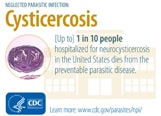Epidemiology & Risk Factors
Cysticercosis is an infection caused by the larvae of the tapeworm, Taenia solium. A person with an adult tapeworm, which lives in the person’s gut, sheds eggs in the stool. The infection with the adult tapeworm is called taeniasis. A pig then eats the eggs in the stool. The eggs develop into larvae inside the pig and form cysts (called cysticerci) in the pig’s muscles or other tissues. The infection with the cysts is called cysticercosis. Humans who eat undercooked or raw infected pork swallow the cysts in the meat. The larvae then come out of their cysts in the human gut and develop into adult tapeworms, completing the cycle.
People get cysticercosis when they swallow eggs that are excreted in the stool of people with the adult tapeworm. This may happen when people
- Drink water or eat food contaminated with tapeworm eggs
- Put contaminated fingers in their mouth
Cysticercosis is not spread by eating undercooked meat. However, people get infected with tapeworms (taeniasis) by eating undercooked infected pork. People who have tapeworm infections can infect themselves with the eggs and develop cysticercosis (this is called autoinfection). They can also infect other people if they have poor hygiene and contaminate food or water that other people swallow. People who live with someone who has a tapeworm infection in their intestines have a much higher risk of getting cysticercosis than other people.
Human cysticercosis is found worldwide, especially in areas where pig cysticercosis is common. Both taeniasis and cysticercosis are most often found in rural areas of developing countries with poor sanitation, where pigs roam freely and eat human feces. Taeniasis and cysticercosis are rare among persons who live in countries where pigs are not raised and in countries where pigs do not have contact with human feces. Although uncommon, cysticercosis can occur in people who have never traveled outside of the United States if they are exposed to tapeworm eggs.
More on: Taeniasis
